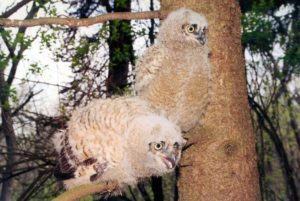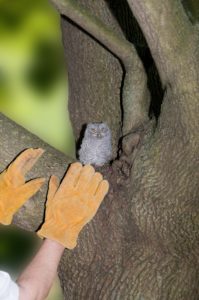Large owls, such as great horned owls, leave the nest weeks before they can fly. The parents continue tending to them. Once they begin to develop feathers, they are able to defend themselves against common predators such as cats. Large dogs, however, may pose a threat. If the owls are still down-covered, they may not have yet developed enough to protect themselves, and they should be moved up into a nearby tree.
Great horned owl babies are often found on low branches, logs, or even on the ground.
Smaller species of owls, such as screech owls, cannot defend themselves and, if they cannot yet fly, should be placed up in a tree out of harm’s way.
Some species, such as the short-eared and snowy owls, nest directly on the ground.
Your definition of an inappropriate location may be different from that of the parents who chose this nesting site. Carefully consider the location and how you may be able to reunite the family. Usually, baby owls should be just left alone.
If you haven’t seen the parents and you can safely do so, move the baby into a more secluded or safer place in that same area.
A baby owl in the middle of a busy street may be able to be moved to the surrounding forest.
A baby owl in the middle of a busy urban neighborhood is in grave danger. If it is not injured and you know the nesting area (probably a local group of conifer trees), perhaps the bird can be returned to the nesting area. If the location is such that it is far too dangerous for the bird, then call a rehabilitator.
Monitor the owlet for a few days. If it remains strong and healthy, the parents are caring for it. If it becomes weakened, then call a rehabilitator.
Find a Rehabilitator
GET THE BOOK
Your POCKET REFERENCE GUIDE to injured or orphaned wild animals!
Print book available on Amazon – $9.95
Available on Kindle – $2.99
Free on Kindle Unlimited
When rescuin g injured wildlife, the choices you make will impact that animal’s life and possibly your own. Knowing about the risks to the animal as well as to you, your family and your pets, along with the right advice from the beginning can mean the difference between a heartwarming, educational experience and disaster.
g injured wildlife, the choices you make will impact that animal’s life and possibly your own. Knowing about the risks to the animal as well as to you, your family and your pets, along with the right advice from the beginning can mean the difference between a heartwarming, educational experience and disaster.
This informative guide teaches would-be rescuers how to identify an animal in need, capture that animal, and safely transport it to a wildlife rehabilitator.
• How to determine the status of an injured creature using easy-to-follow flow charts
• Instructions on safe-capture methods, emergency care, transportation, and finding a professional wildlife rehabilitator

